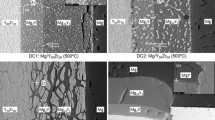Abstract
The glass-forming ability (GFA) of two alloy systems, Mg-Y-La and Mg-Zn-Nd, was investigated using thermal and microstructural analysis. Rapid solidification was found to lead to microstructural refinement and partial amorphization of the most investigated alloys. The addition of Cu to the Mg-Y-La group was found to increase its tendency to undergo amorphization during rapid solidification, exemplified by the Mg86Y9.5Cu2.5La2 alloy exhibiting a pronounced crystallization peak in the differential scanning calorimetry trace. Two Mg-Zn-Nd alloys, Mg71Zn28Nd and Mg73.6Zn22.1Nd4.3, were found to exhibit significant amorphous behavior, with the former alloy being more amorphous than the latter. An innovative model predicting the GFA of alloys based on spinodal-like decomposition of supercooled alloys is formulated herein. New generalized thermo-kinetic criteria for spinodal decomposition of ternary alloys for time/space-correlated fluctuations were formulated. The time-dependent amplification factor of concentration fluctuations in ternary systems was found to provide adequate GFA evaluation for the compositions of both alloy systems: Mg-Y-La and Mg-Zn-Nd. The model was able to pinpoint the most amorphous alloy in each alloy system, and comparison between both systems pointed to Mg71Zn28Nd as having the best GFA, while also recognizing that it has a lower GFA than the widely known and highly glass-formable Mg65Cu25Y10 alloy. This model is expected to predict the GFA of any envisaged composition, thereby avoiding cumbersome trials.










Similar content being viewed by others
Abbreviations
- A0, B0 :
-
Compositional fluctuation amplitudes of elements A and B
- C :
-
Concentration
- (D X)0 :
-
Pre-exponential factor of the diffusion coefficient of element X in Mg matrix
- D X :
-
Diffusion coefficient/diffusivity of element X in Mg matrix
- (D M)0 :
-
Pre-exponential factor of the self-diffusion coefficient of Mg
- D M :
-
Self-diffusion coefficient/self-diffusivity of Mg matrix
- d :
-
Interatomic distance
- E X :
-
Energy barrier for diffusion of element X in Mg matrix
- E M :
-
Energy barrier for self-diffusion in Mg
- G :
-
Gibbs free energy
- g :
-
Molar Gibbs free energy
- ΔH c(tot) :
-
Total enthalpy change of crystallization
- ΔH m :
-
Enthalpy change of melting
- \( \Delta H_{\text{m}}^{0} \) :
-
Enthalpy change of melting for a 100 pct crystalline material
- M ij :
-
Effective binary mobility
- pc :
-
Crystallinity percentage
- Q :
-
Growth rate of amplification factor in compositional fluctuations in spinodal decomposition of ternary alloys
- T :
-
Temperature
- T 0 :
-
Temperature at which spinodal decomposition starts
- t :
-
Time
- β :
-
Space wavenumber of compositional fluctuations
- η :
-
Cooling rate
- κ ij :
-
Gradient energy coefficient of binary interaction of elements i, j
- λ :
-
Wavelength of compositional fluctuation in spinodal decomposition
- ξ :
-
Empiric coefficient describing the melting-to-crystallization enthalpy ratio for a 100 pct amorphous material
References
M. Telford: Mater. Today, 2004, pp. 36–43.
2. A. Gebert, U. Wolff, A. John and J. Eckert: Scripta Materialia, 2000. Vol. 43, pp. 279-283.
3. M.M. Trexler and N.N. Thadhani: Progress in Materials Science, 2010, Vol. 55, no. 8, pp. 759-839.
A. Inoue and T. Masumoto: Materials Science and Engineering A, 1993, Vol. 173, pp. 1-8.
5. A. Inoue, A. Kato, T. Zhang, S. G. Kim and T. Masumoto: Materials Transactions JIM, 1991, Vol. 32, no. 7, pp. 609-616.
J. Berry, K. R. Elder and M. Grant: Physical Review E, 2008, Vol 77, no. 06(1506), pp. 1-7
G.I. Tóth, T. Pusztai, G. Tegze, G. Tóth and L. Gránaśy: Physical Review Letters, 2011, Vol 107, no. 17(5702), pp. 1-4
A. J. Archer, M. J. Robbins, U. Thiele and E. Knobloch: Physical Review E, 2012, Vol 86, no. 03(1603), pp. 1-13
E. Eshed, M. Bamberger, and A. Katsman: MRS Proceedings—Symposium II—Bulk Metallic Glasses, Materials Research Society, 2014, vol. 1649.
10. S. Bhattacharyya and T.A. Abinandanan: Bull. Mater. Sci., 2003, Vol. 26, no. 1, pp. 193-197.
Z. R. Liu and H. Gao: The European Physical Journal B, 2004, Vol. 37, pp. 369-374.
J. Bohong, Z. Meihua, W. Qing, X. Zuyao: Acta Metallurgica Sinica (English Edition) Series B, 1991, Vol. 4, no. 2, pp. 75-81.
W.F. Gale, and T.C. Totemeir: Smithells Metals Reference Book, 8 th edition, volume 13, pp. 1-120 2004, Elsevier Butterworth-Heinemann, Oxford
J. Čermák and I. Stloukal: Metal 2008—17th International Metallurgical & Material Conference, Hradec nad Moravicí, Czech Republic, 13–15 May 2008, pp. 1–8.
15. L.Huber, Ilya Elfimov, Jörg Rottler and Matthias Militzer: Physical Review B, 2012, Vol. 85, no. 144301, pp. 1-7.
16. T. H. Hung, Y. C. Chang, H. M. Chen, Y. L. Tsai, J. C. Huang, J. S. C. Jang and T. G. Nieh: Materials Science Forum, 2007, Vols. 539-543, pp. 1926-1931.
17. A. Gebert, U. Wolff, A. John, J. Eckert and L. Schultz: Materials Science and Engineering A, 2001, Vol. 299, pp. 125-135.
Author information
Authors and Affiliations
Corresponding author
Additional information
Manuscript submitted January 20, 2015.
Rights and permissions
About this article
Cite this article
Eshed, E., Bamberger, M. & Katsman, A. A Spinodal Decomposition Model for the Prediction of the Glass-Forming Ability of Ternary Mg Alloys. Metall Mater Trans A 47, 209–221 (2016). https://doi.org/10.1007/s11661-015-3194-8
Published:
Issue Date:
DOI: https://doi.org/10.1007/s11661-015-3194-8




